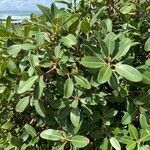Evergreen, aromatic, woody, resinous tree, 2-10 m high; schizogenous secretory canals present. Leaves alternate, ± obovate, entire, glabrous; petiolate; estipulate. Inflorescences terminal or axillary, paniculate. Flowers cream-coloured, bisexual or unisexual; pentamerous, sweet-scented. Sepals free, deciduous. Petals ± connate to middle, claws connivent, blades spreading. Ovary superior, carpels 2, 1-locular; style, short. Fruit a ± globose capsule; valves 2, entire, leathery, brown, splitting through persistent style. Seeds 4-8 per valve, in 2 rows on each parietal placenta, orange to red, covered by resin.
Adult leaves glabrous or faintly appressed-pubescent on petiole and midrib, very variable in size and shape, with lamina (including petiole) up to 11 x 4 cm., usually obovate to broadly oblanceolate, rounded or shortly acuminate, length-breadth ratio usually less than 3: 1, rarely narrower and longer acuminate, in age usually glaucescent and ± tessellate above, rarely smoother, dull or somewhat glossy; midrib flat or slightly impressed; nerves generally thin, flat, rarely prominulous beneath, merging into the reticulation, often somewhat conspicuous above; reticulation dense, uniform.
Shrub or small tree, up to 10 m high. Leaves with blade obovate to narrowly obovate, very variable in size, apex rounded to acute, margins entire, upper surface shiny dark green, lower surface paler green with conspicuous net-veining, clearly visible against the light. Flowers: in branched terminal heads; corolla lobes creamy yellow or greenish yellow, 6-7 mm long; Sep.-Jan. Fruit a globose, yellowish brown, woody capsule, 5-10 mm in diameter, with bright orange-red, sticky seeds.
A tree. It grows 10-25 m high. The trunk is light grey with darker bands of cells. It is densely leafy and the leaves are leathery. The leaves are 7 cm long by 3 cm wide. There is often a notch at the tip. The flowers are in dense clusters at the top of the plant. The petals are greenish-yellow. The fruit is downy but becomes hairless when ripe. There are few seeds. They have a bright orange sticky covering over them.
Shrub or small tree, up to 10 m high. Leaves obovate to oblanceolate, lower surface with conspicuous net-veining. Capsule with orange-red, sticky seeds. Flowers dull white.
Tree or shrub to 20 m, thinly hairy on young parts. Leaves leathery, oblanceolate, margins revolute. Flowers in terminal panicles, creamy, fragrant seeds red, sticky.
Capsules (in our area probably always) 4-seeded; valves of the ripe capsule plano-convex or dorsally gibbous, spreading or bent slightly upwards.
Inflorescences rather dense, rarely reduced, with (in our area always) ± pubescent branches.
Sepals free and up to 1.5 mm. long or rarely longer and variously connate.
Tree up to 10 m. high or large shrub.
Petals usually greenish-white.


